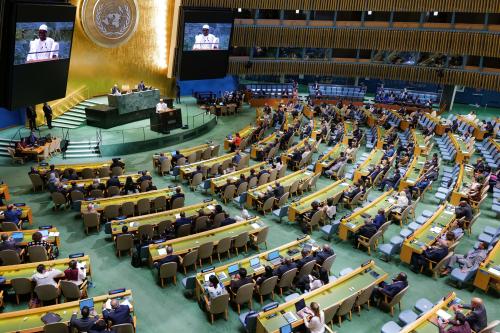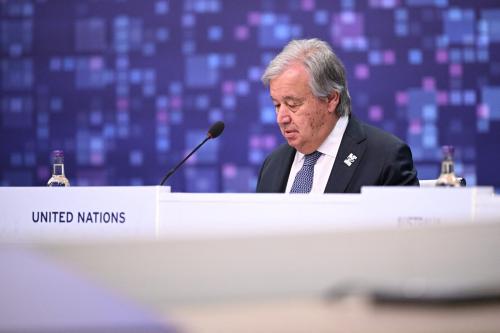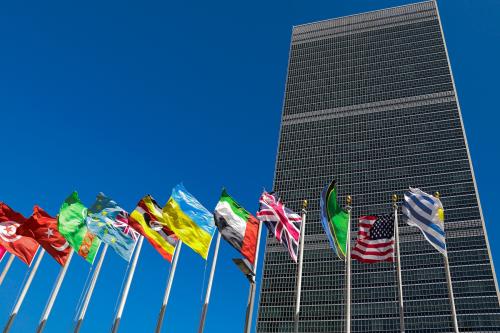Malaria, tuberculosis, and the strains of AIDS common in developing countries kill five million people each year. Over the last 50 years, these diseases have killed six times as many people as have died in all wars. Yet research on vaccines for these diseases remains minimal. These diseases primarily affect poor countries, and therefore potential vaccine developers believe they will be unable to sell enough vaccine at a sufficient price to recoup their research costs. Moreover, research and development on vaccines is a global public good in which no one country has sufficient incentive to invest.
World Bank president James Wolfensohn recently told the Financial Times that the Bank plans to create a $1 billion fund to help countries purchase specified vaccines if and when they are developed. Such a fund could help ensure that there would be a market for malaria, tuberculosis, or AIDS vaccines if they were developed, and thus would create incentives for vaccine research. It could also help ensure that any vaccines developed would be affordable in poor countries. The program would be highly focused on areas of deep poverty and would be highly cost effective.
Wolfensohn’s proposal is being discussed within the Bank and would have to be approved by the Bank’s board. One option under consideration is a more general program to combat communicable diseases of the poor. For a general program to stimulate research, it must include an explicit commitment to help finance the purchase of new vaccines if and when they are developed. Without an explicit commitment along the lines proposed by Wolfensohn, it is unlikely that the large scale investments needed to develop vaccines will be undertaken.
POLICY BRIEF #57
The Need for New Vaccine Research
Vaccines are among the world’s most effective health interventions. Three million lives are saved each year by a standard package of cheap, off-patent vaccines which reaches three-quarters of the world’s children. Coverage is considerably lower for newer vaccines.
However, despite recent scientific advances which have increased the feasibility of developing malaria, tuberculosis, and AIDS vaccines, global R&D on these vaccines is woefully inadequate. Funds for global public and non-profit malaria research in 1993 totaled only about $84 million, with only a small part of that devoted to vaccine research. The amount of private sector spending is unknown, but is generally considered to be even smaller. This investment is trivial compared to the amount spent to combat diseases which primarily affect richer countries.
The lack of investment in R&D reflects severe distortions in the market for vaccines. Overcoming these distortions requires a public, global, credible commitment to encourage vaccine research and development.
The Need for Public Action
In the vast majority of countries, vaccines are purchased and distributed by governments. This is because the beneficiaries are often children who are unable to make decisions on their own and because the immunization of one person benefits others by breaking the chain of disease transmission. While vaccine R&D is costly and risky, production is typically subject to economies of scale, so manufacturing additional doses increases costs only modestly. By purchasing large quantities of vaccines at relatively low prices, governments have the potential to simultaneously increase incentives for vaccine developers and increase affordability of vaccines.
The Need for Global Action
Vaccine research is a global public good. Many countries will benefit from the development of new vaccines. No one country, however, has sufficient incentive to finance the necessary research or to provide the intellectual property rights protection which would help stimulate private research. The solution is for countries to group together and take action at a global level.
The Need for a Credible Commitment
Government policy toward vaccines can suffer from a “time inconsistency” problem. Prior to the development of a vaccine, governments may be willing to promise prices for a vaccine which cover R&D costs. After a vaccine has been developed, however, governments have an incentive to bargain down the price to a level which does not fully cover the R&D costs. Governments are able to bargain down prices because they are arbiters of intellectual property rights, vaccine regulators, and often the sole purchasers. Most vaccines sold in developing countries are provided for pennies per dose; the newer vaccines, priced at a dollar or two per dose, do not reach many of the poorest countries. So potential developers are reluctant to make the expensive and risky R&D investments needed to develop new vaccines. Any commitment to purchase vaccines, therefore, needs to be sufficiently credible to assure developers that governments will not renege once a vaccine has been developed.
The Role of the World Bank
The World Bank is in an ideal position to lead a global public effort to encourage private vaccine research for malaria, tuberculosis, and developing-country strains of AIDS. Other institutions are already spending public funds to finance research by providing grants to academics, conducting vaccine research in public laboratories, and funding joint public-private research ventures. The World Bank’s expertise and potential role in these areas is limited, but it can encourage private research through its core activity of lending to governments. In particular, the Bank can provide the necessary incentive for private developers to invest in R&D by pledging to provide concessional loans through the World Bank’s International Development Association (IDA) to ensure that countries can purchase suitable vaccines if and when they become available. By helping assure private firms that there will be a market if vaccines are developed, the Bank can encourage R&D investment by the private sector.
This method of encouraging R&D has a number of advantages over direct research funding. A commitment to help finance purchases of suitable new vaccines requires no spending unless and until such vaccines are developed. It avoids the need to choose between research on new vaccines and current needs, such as increasing access to existing vaccines, or fighting malaria, tuberculosis, and AIDS using existing technologies. It also allows biotech and pharmaceutical firms and scientists themselves to select which research avenues to pursue, rather than establishing a new bureaucracy to make these decisions. Since the developers have the most information about the prospects for various research projects, they are best suited to make these decisions. Finally, by pledging to make sufficient resources available at concessional rates to countries purchasing the vaccines, the Bank will ensure that the vaccines are accessible to developing countries once they are produced.
Earmarking future IDA credits for a particular purpose is sometimes regarded as undesirable because it reduces the flexibility of the Bank to provide loans where they are most needed and would achieve the greatest benefit. However, in the case of vaccines, earmarking is necessary to address the time inconsistency problem and to convince developers that there will be a market for their product. In any case, it would be hard to imagine a situation in which purchasing vaccines for malaria, tuberculosis, and AIDS would not be a very high development priority.
The Role of Donors
The Bank’s effort could be supplemented by additional support from donor countries. In his 2000 budget, President Clinton proposed a tax incentive for producers of new vaccines against malaria, tuberculosis, HIV, or other infectious diseases which kill over one million people each year. Under the proposal, each dollar of vaccine sales would be matched with a dollar reduction in the developer’s tax liability. This would effectively double the value of any incentive provided by the Bank, up to a limit of $1 billion over the 2002-2010 period. (If credits remained unallocated, they could be rolled over for ten years.) Support from other bilateral donors should be sought to further increase the incentive to develop vaccines and to subsidize the purchase of vaccines by countries which are not eligible for IDA credits.
A Purchase Commitment Would Not Conflict with Current Priorities
An explicit commitment to help finance purchases of new vaccines will not interfere with other initiatives to tackle communicable diseases of the poor. This is because the commitment does not have to be financed unless and until a vaccine is developed. So, for example, the Bank could provide loans now to help prevent the spread of AIDS, promote the use of netting against malaria-bearing mosquitoes, or increase coverage of existing vaccines, while committing that if and when new vaccines are developed, it will provide IDA credits to countries purchasing these vaccines.
Increasing purchases of existing vaccines is valuable in its own right, and it may help persuade potential developers that the market for vaccines may be better in the future than it has been in the past. However, increased purchases of existing vaccines are unlikely to be sufficient, by themselves, to assure potential vaccine developers that there will be a large market for new vaccines. This is because lead times for vaccine development may be ten years or more, and developers would need to recoup their research expenditures through sales over the subsequent ten years. Political winds shift, and donors are fickle in setting spending priorities, so increased spending now, by itself, does not guarantee spending in the future.
The Program Would Be Highly Poverty Focused
Pledging credits to help countries purchase vaccines would be highly focused on the poorest countries. Eighty percent of the 2.3 million people who died of AIDS last year lived in sub-Saharan Africa and almost 90 percent of malaria cases are in sub-Saharan Africa. Tuberculosis is concentrated in Africa and South Asia. Of those countries where the burden of the disease is sufficient to make widespread vaccination cost effective, over 70 percent are IDA eligible. The poorest groups within each country are the ones least likely to be able to afford to take preventive steps, such as purchasing mosquito nets to protect against malaria.
Loans Will Need to Be on IDA Terms
Commitments by one country to purchase vaccines benefit other countries by encouraging vaccine research and development. No one country, therefore, has a sufficient incentive to make a commitment on its own (the public good problem). In addition, once a vaccine is developed, countries will want to bargain down the price of the vaccine below the level needed to recoup the R&D costs (the time inconsistency problem). Anticipating this, developers have been reluctant to undertake the necessary research.
One solution is for donors to commit to help developing countries purchase the vaccine. Ideally, developing countries would be able to purchase the vaccine at a price close to the production cost, and the donors would pay for the R&D expenditure, which is a global public good.
Vaccine Purchases Should Not Lead to Cuts in a Country’s Other IDA Programs
Countries are restricted in the level of IDA credits which they can draw on in any one year. It is possible that, once a vaccine is developed, countries would be reluctant to use their limited IDA funds to purchase the vaccine at the price agreed to by the World Bank. Instead, they might attempt to purchase the vaccine outside the World Bank terms at a price that covers only manufacturing but not R&D costs. They could then use their scarce IDA credits for other projects.
This is a reflection of the time inconsistency problem discussed above. Before a vaccine has been developed, countries may be willing, as a group, to commit to use IDA resources to purchase the vaccine to help encourage vaccine development. Once the vaccine has been developed, however, countries have an incentive to renege on the commitment and go outside the terms of the IDA commitment and bargain for a lower price which does not cover R&D costs. If developers anticipate this, they will be deterred from undertaking the R&D in the first place.
It is essential to provide developers with a credible commitment that a sufficient value of purchases will be made to recoup the R&D costs. To provide the necessary assurance to developers, IDA will need to make a commitment that, once a vaccine which meets the standards set by the Bank is developed, a certain level of IDA resources will be available for purchases of the vaccine. Any IDA eligible country where a vaccination effort would be cost effective will be permitted to apply for these resources. These should be reserved for vaccine purchases, and countries which apply for the resources should not suffer a reduction in their IDA allocations for other projects.
Determining Eligibility Criteria
The Bank should set minimum standards which all vaccines must meet to be considered eligible for IDA credits and loans subsidized from a donor trust fund. Potential vaccine developers will then know what they are aiming for. The criteria should be sufficiently tough to ensure that the Bank gets good value for its money. However, they should not be so stringent that potential developers are put off and potentially useful vaccines are ruled ineligible. The Bank may want to commit itself to make additional resources available and pay a higher price for vaccines which outperform the minimum standard.
Size of the Fund
The R&D costs of developing a vaccine represent a large fraction of the total costs of production. These costs do not vary much with the quantity of vaccine produced. Potential developers, therefore, will be more concerned about the total size of the market for a vaccine (price multiplied by quantity) than about the likely price per dose. By coordinating the purchase of a large quantity of the vaccine, therefore, the Bank can provide the necessary incentive to developers while still ensuring the vaccine is purchased at a relatively modest price per dose.
The larger the market for a potential vaccine, the greater the incentive to invest in R&D. With a larger potential market, more developers are likely to invest in research and more candidate vaccines will be pursued in parallel, reducing the expected time until a successful candidate is found. There is, therefore, no set size of market which is necessary to provide incentive to developers. However, a rough rule of thumb is that potential developers require an expected annual market of $250 million to undertake a serious research program.
If vaccines for AIDS, tuberculosis, and malaria were developed simultaneously, this would suggest the need for a combined market of at least $750 million a year or $7.5 billion over 10 years. It is unlikely that all three vaccines will be developed at the same time. However, if the Bank could provide credits for the purchase of only one vaccine at a time, potential developers would be reluctant to invest because of the risk that a vaccine for another disease would be developed first, and they would be unable to sell their product. The global community should, therefore, be prepared to purchase at least two vaccines at the same time. This would require a potential market of $500 million annually for 10 years – although this maximum would only be reached under the optimistic scenario in which vaccines for two diseases were developed at the same time. If a vaccine for only one disease is produced, the additional pledge will have provided an additional incentive to the developer, but this would have come at no additional cost to the Bank or donors. Of the $500 million needed annually, $100 million would be provided by the U.S. administration’s tax proposal, if it is adopted by Congress. The rest would need to be provided by the Bank and other donors. Assuming the U.S. tax proposal is passed, the remaining $400 million needed to purchase two vaccines would represent 5.7 percent of FY1999 IDA commitments (although some of the loans would be to non-IDA eligible countries). Under the more likely scenario in which one vaccine was developed at a time, $150 million, or 2.1 percent of FY1999 IDA commitments, would be needed. Even the larger amount could, if necessary, be comfortably financed by repayments from previous IDA loans, in the absence of new contributions to IDA.
These calculations are based on an assumption that subsidized loans to purchase vaccines will only be needed for the first 10 years following the development of a vaccine. The expectation would be that, after ten years, competing vaccines would be developed, making vaccines more affordable for developing countries and agencies such as UNICEF.
Cost Effectiveness
Providing subsidized loans to assist countries purchasing vaccines would be an extremely cost effective way to improve the health of some of the poorest people in the world. If the Bank committed to provide $150 million a year for purchases of a malaria vaccine, for example, with the US tax credit providing an additional $100 million, over 450 million children and pregnant women could be vaccinated against malaria over ten years at a cost to the Bank of $3.25 per person, or $5.40 if the cost of the U.S. tax credit is included. The cost per Disability Adjusted Life Year (DALY) saved over a ten-year horizon would be $13 (including the cost of administering the vaccine and the cost of the U.S. tax incentive). The cost per DALY would be much lower if the program were assessed over a longer time horizon, as the price of the vaccines is likely to fall over time. For reference, the World Development Report on health in 1993 termed interventions costing less than $100 per DALY saved as “highly cost effective.” If no vaccine were developed, no money would be spent.
Conclusion
A World Bank vaccine purchase fund which could provide up to $400 million a year in credits to countries purchasing vaccines for malaria, tuberculosis, and AIDS would be a highly cost effective way to improve the health of some of the poorest people in the world. Credits provided by the Fund would represent only 2.1- 5.7 percent of IDA commitments in FY1999. A commitment to help finance purchases of new vaccines would require no outlays unless and until these vaccines were developed, and hence would not conflict with current priorities.




